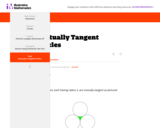
This is a challenging task which requires students to carefully divide up the picture into different pieces for which the area is known.
- Provider:
- Illustrative Mathematics
- Date Added:
- 06/22/2022

This is a challenging task which requires students to carefully divide up the picture into different pieces for which the area is known.
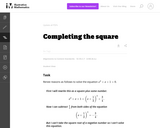
This is a task from the Illustrative Mathematics website that is one part of a complete illustration of the standard to which it is aligned. Each task has at least one solution and some commentary that addresses important asects of the task and its potential use. Here are the first few lines of the commentary for this task: Renee reasons as follows to solve the equation $x^2 + x + 1 = 0$. First I will rewrite this as a square plus some number. x^2 + x + 1 = \left(x+\frac{1...

This is a task from the Illustrative Mathematics website that is one part of a complete illustration of the standard to which it is aligned. Each task has at least one solution and some commentary that addresses important asects of the task and its potential use. Here are the first few lines of the commentary for this task: For this task, the letter $i$ denotes the imaginary unit, that is, $i=\sqrt{-1}$. For each integer $k$ from 0 to 8, write $i^k$ in the form $a+bi$. Des...
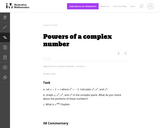
This is a task from the Illustrative Mathematics website that is one part of a complete illustration of the standard to which it is aligned. Each task has at least one solution and some commentary that addresses important asects of the task and its potential use. Here are the first few lines of the commentary for this task: Let $z = 1 + i$ where $i^2 = -1$. Calculate $z^2, z^3,$ and $z^4$. Graph $z, z^2, z^3,$ and $z^4$ in the complex plane. What do you notice about the po...

This is a task from the Illustrative Mathematics website that is one part of a complete illustration of the standard to which it is aligned. Each task has at least one solution and some commentary that addresses important asects of the task and its potential use. Here are the first few lines of the commentary for this task: A small company wants to give raises to their 5 employees. They have $10,000 available to distribute. Imagine you are in charge of deciding how the rai...

This is a task from the Illustrative Mathematics website that is one part of a complete illustration of the standard to which it is aligned. Each task has at least one solution and some commentary that addresses important aspects of the task and its potential use.
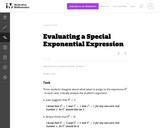
This is a task from the Illustrative Mathematics website that is one part of a complete illustration of the standard to which it is aligned. Each task has at least one solution and some commentary that addresses important asects of the task and its potential use. Here are the first few lines of the commentary for this task: Three students disagree about what value to assign to the expression $0^0$. In each case, critically analyze the student's argument. Juan suggests that...
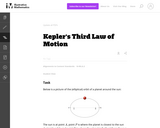
This is a task from the Illustrative Mathematics website that is one part of a complete illustration of the standard to which it is aligned. Each task has at least one solution and some commentary that addresses important asects of the task and its potential use. Here are the first few lines of the commentary for this task: Below is a picture of the (elliptical) orbit of a planet around the sun: The sun is at point $A$, point $P$ is where the planet is closest to the sun d...

The goal of this task is to show that when the whole is not specified, which fraction is being represented is left ambiguous.

This task applies geometric concepts, namely properties of tangents to circles and of right triangles, in a modeling situation.

This task applies geometric concepts, namely properties of tangents to circles and of right triangles, in a modeling situation. The key geometric point in this task is to recognize that the line of sight from the mountain top towards the horizon is tangent to the earth. We can then use a right triangle where one leg is tangent to a circle and the other leg is the radius of the circle to investigate this situation.

The coffee cooling experiment is a popular example of an exponential model with immediate appeal. The model is realistic and provides a good context for students to practice work with exponential equations.
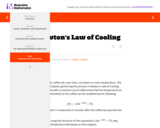
The coffee cooling experiment in this task is a popular example of an exponential model with immediate appeal. The model is realistic and provides a good context for students to practice work with exponential equations.
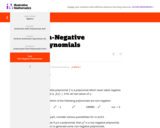
The task helps foster student understanding of the analogy described in the standard -- "Understand that polynomials form a system analogous to the integers..." -- in addition to having the same arithmetic operations available, there are many other instances in which integers and polynomials share common properties.
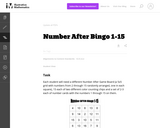
This number after bingo activity increases student flexibility with the number sequence and their ability to start counting sequences at various points.
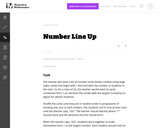
This number line up activitiy gets students out of their seats and helps reinforce the counting sequence.
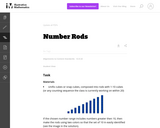
This activity gives students practice counting for meaning.
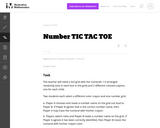
This activity is played in pairs and gives students practice reading numbers out loud and tracing them.
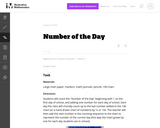
Students learn the connection between the counting sequence and experience from their daily lives in this daily activity. It also helps give students a sense of how "many" each number is.

This deceptively simple task asks students to find the domain and range of a function from a given context. The function is linear and if simply looked at from a formulaic point of view, students might find the formula for the line and say that the domain and range are all real numbers. However, in the context of this problem, this answer does not make sense, as the context requires that all input and output values are non-negative integers, and imposes additional restrictions.